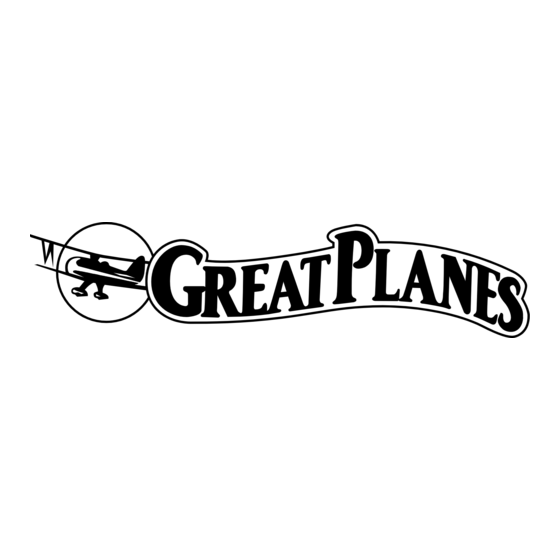GREAT PLANES Big Stir 40 사용 설명서 - 페이지 17
{카테고리_이름} GREAT PLANES Big Stir 40에 대한 사용 설명서을 온라인으로 검색하거나 PDF를 다운로드하세요. GREAT PLANES Big Stir 40 20 페이지.

BALANCE YOUR MODEL (C.G.)
Note: This section is VERY important and must NOT be
omitted! A model that is unbalanced will be unstable
and possibly unflyable.
Big Stik .40 ARF
4-1/16"
❏
1. The balance point is located 4-1/16" back from the
leading edge of the wing. Mark this location on the bottom
of both sides of the wing at the fuselage. This is the balance
point that should be used for your first flights. After you have
become familiar with the plane you may wish to experiment
by moving the C.G. forward or aft up to 3/8" to change its
flight characteristics. Do not at any time balance your model
outside the recommended range.
Big Stik .60 ARF
4-5/8"
The balance point is located 4-5/8" back from the leading
edge of the wing. Mark this location on the bottom of both
sides of the wing at the fuselage. This is the balance point
that should be used for your first flights. After you have
become familiar with the plane you may wish to experiment
by moving the C.G. forward or aft up to 3/8" to change its
flight characteristics. Do not at any time balance your model
outside the recommended range.
❏
2. With all of the parts of the model installed (ready to fly)
and an empty fuel tank, lift the model at the balance point. If
the tail drops the plane is "tail heavy" and you must add
weight to the nose to balance the model. If the nose drops,
it is "nose heavy" and you must add weight to the tail to
balance the model.
❏
3. If possible try to balance the model by changing the
position of the receiver battery. If you are unable to obtain
good balance by doing so, then it will be necessary to add
weight to the nose or tail to achieve a proper balance point.
PREFLIGHT
At this time check all connections including servo horn
screws, clevises, servo cords and extensions. Make sure
you have installed the nylon retainer on the Screw-Lock
Pushrod Connector and the silicon retainers on all clevises.
Be sure that you have followed all of the instructions of the
radio manufacturer including running the antenna out the
fuselage to the tail.
Charge the Batteries
Follow the battery charging procedure in your radio instruction
manual. You should always charge your transmitter and
receiver batteries the night before you go flying and at other
times as recommended by the radio manufacturer.
Balance the Propeller
Carefully balance your propellers before flying. An unbalanced
prop is the single most significant cause of vibration. We
recommend the Top Flite Precision Magnetic Balancer
(TOPQ5700) and the Top Flite Fingertip Balancer (GPMQ5000).
Find a Safe Place to Fly
The best place to fly your R/C model is an AMA (Academy
of Model Aeronautics) chartered club field. Ask your hobby
shop dealer if there is such a club and join. Club fields are
set up for R/C flying which usually makes your outing more
enjoyable. The AMA can also tell you the name of a club in
your area. We recommend that you join AMA and a local
club so you can have a safe place to fly and also have
insurance to cover you in case of a flying accident.
Ground Check the Model
Inspect your radio installation and confirm that all of the
control surfaces respond correctly to the transmitter inputs.
The engine operation must also be checked by confirming
that the engine idles reliably, transitions smoothly and
rapidly to full power and maintains full power indefinitely.
The engine must be "broken-in" on the ground by running it
for at least one full tank of fuel. Follow the engine
manufacturer's instructions for "break-in". Make sure that all
screws remain tight and that the prop is on tight.
17
™
